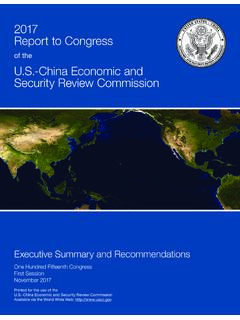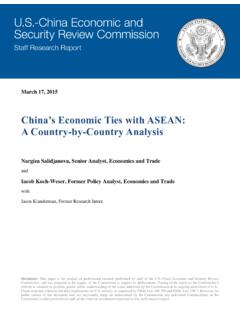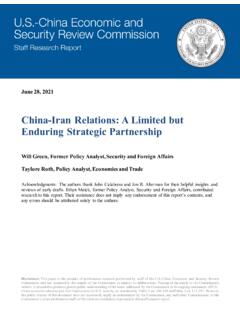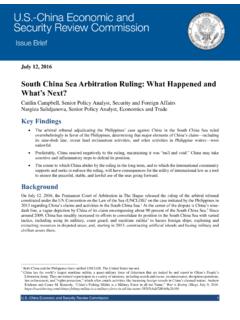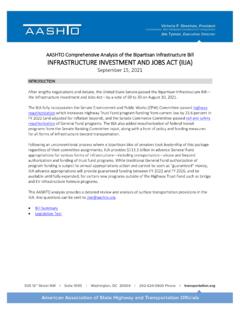Transcription of SECTION 1: BELT AND ROAD INITIATIVE - U.S.- CHINA
1 (259)CHAPTER 3 CHINA AND THE WORLDSECTION 1: BELT AND ROAD INITIATIVEKey Findings In 2013, Chinese President and General Secretary of the Chi-nese Communist Party Xi Jinping inaugurated the Belt and Road INITIATIVE (BRI), his signature economic and foreign policy project designed to finance and build infrastructure and con-nectivity around the world, with a focus on Eurasia and the Indo-Pacific region. Although there is no official definition for BRI, after five years, CHINA s objectives for BRI are discernable: fueling do-mestic development and increasing control in CHINA s outer provinces, expanding markets while exporting technical stan-dards, building hard and digital infrastructure, bolstering en-ergy security, expanding CHINA s military reach, and advanc-ing geopolitical influence by moving CHINA to the center of the global order.
2 Strategic interests are central to BRI, even though the Chinese government denies that BRI advances its geopolitical ambitions. At the same time, BRI will also expose CHINA to major risks, in-cluding terrorism and instability, and political fallout in partner countries. BRI could pose a significant challenge for inter-ests and values because it may enable CHINA to export its model of authoritarian governance and encourages and validates au-thoritarian actors abroad. Beijing sees BRI in part as an externally oriented develop-ment program to boost CHINA s slowing economy and help it move up the global value chain through economic integra-tion with neighboring countries.
3 Chinese planners believe infrastructure development in BRI countries can open new markets and boost foreign demand for Chinese products, par-ticularly in higher-end manufactured goods. Despite Beijing s rhetoric about BRI being open and inclusive, Chinese state-owned enterprises are winning the lion s share of contracts for BRI projects. As CHINA increases its international economic engagement through BRI, Chinese companies are seeking to define and export standards for a broad set of technological applications, including through the so-called Digital Silk Road, which tak-en together could alter the global competitive landscape.
4 BRI 25911/2/2018 10:34:12 AM260potentially threatens businesses and market access as well as the broader expansion of free markets and democratic gover-nance across the globe. BRI offers partner countries much-needed infrastructure fi-nancing, but also presents significant risks. Chinese engage-ment with BRI countries has largely been through infra-structure projects financed by Chinese policy and commercial banks rather than direct investment. Chinese lending poses debt sustainability problems for a number of BRI countries while providing Beijing with economic leverage to promote Chinese interests, in some cases threatening the sovereignty of host countries.
5 Beijing s response to problems of debt dis-tress in BRI countries has ranged from offering borrowers additional credit to avoid default to extracting equity in stra-tegically important assets. A growing People s Liberation Army presence overseas, facilitat-ed and justified by BRI, could eventually create security prob-lems for the United States and its allies and partners beyond CHINA s immediate maritime periphery. CHINA is trying to use BRI to bolster its influence and presence in the Indo-Pacific through access to port facilities and other bases to refuel and resupply its navy, while expanding operations and exercises with regional militaries.
6 CHINA does not have a monopoly on plans to facilitate connec-tivity and spread influence across Eurasia, and BRI is not un-folding in isolation. Other major powers including the United States, Japan, India, European states, and Russia are execut-ing their own initiatives that variously compete and collaborate with BRI. More broadly, skepticism of BRI s purposes and meth-ods appears to be growing worldwide as projects are implement-ed and the INITIATIVE s challenges become more Commission recommends: Congress create a fund to provide additional bilateral assis-tance for countries that are a target of or vulnerable to Chinese economic or diplomatic pressure, especially in the Indo-Pacific region.
7 The fund should be used to promote digital connectivity, infrastructure, and energy access. The fund could also be used to promote sustainable development, combat corruption, pro-mote transparency, improve rule of law, respond to humanitari-an crises, and build the capacity of civil society and the media. Congress require the Department of State to prepare a re-port to Congress on the actions it is taking to provide an alter-native, fact-based narrative to counter Chinese messaging on the Belt and Road INITIATIVE (BRI).
8 Such a report should also ex-amine where BRI projects fail to meet international standards and highlight the links between BRI and CHINA s attempts to suppress information about and misrepresent reporting of its human rights abuses of Uyghurs in 26011/2/2018 10:34:12 AM261 Congress require the Director of National Intelligence to pro-duce a National Intelligence Estimate (NIE), with a classified annex, that details the impact of existing and potential Chinese access and basing facilities along the Belt and Road on freedom of navigation and sea control, both in peacetime and during a conflict.
9 The NIE should cover the impact on , allied, and regional political and security s expansive Belt and Road INITIATIVE (BRI) is the signa-ture foreign policy and geoeconomic project of Chinese President and General Secretary of the Chinese Communist Party (CCP) Xi Jinping, who has extolled it as the project of the century. 1 Since its inception in 2013, BRI has climbed to the top of Beijing s foreign policy agenda as a well-resourced, whole-of-government concept for regional and global connectivity.
10 What BRI means in practice is still coming into focus, but Beijing s aspirations for the INITIATIVE are clear: encouraging domestic development and increasing control in CHINA s outer provinces, expanding markets and exporting technical standards, building hard and digital in-frastructure, bolstering energy security, expanding the reach of CHINA s military to protect overseas interests, and advancing geo-political influence. The INITIATIVE has security implications for the United States and its allies and partners, including expanding CHINA s military influence, overseas presence, and access to for-eign is using BRI to challenge and allied interests and the international rules-based order predicated on open markets and democratic, transparent governance.

